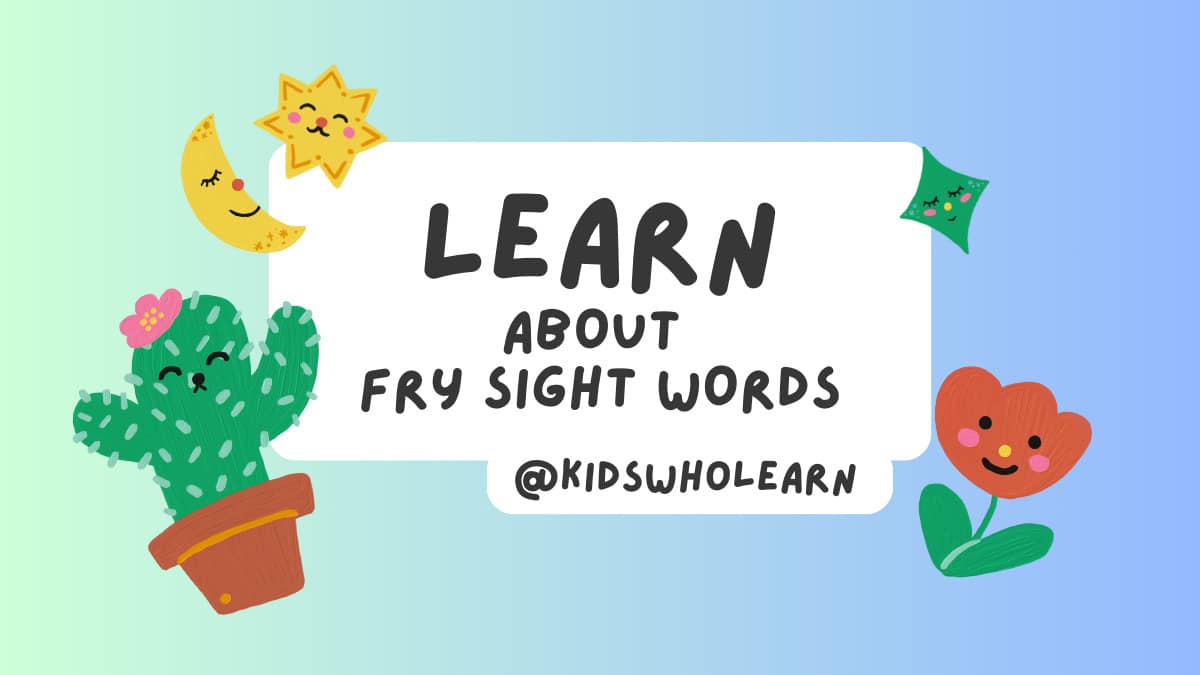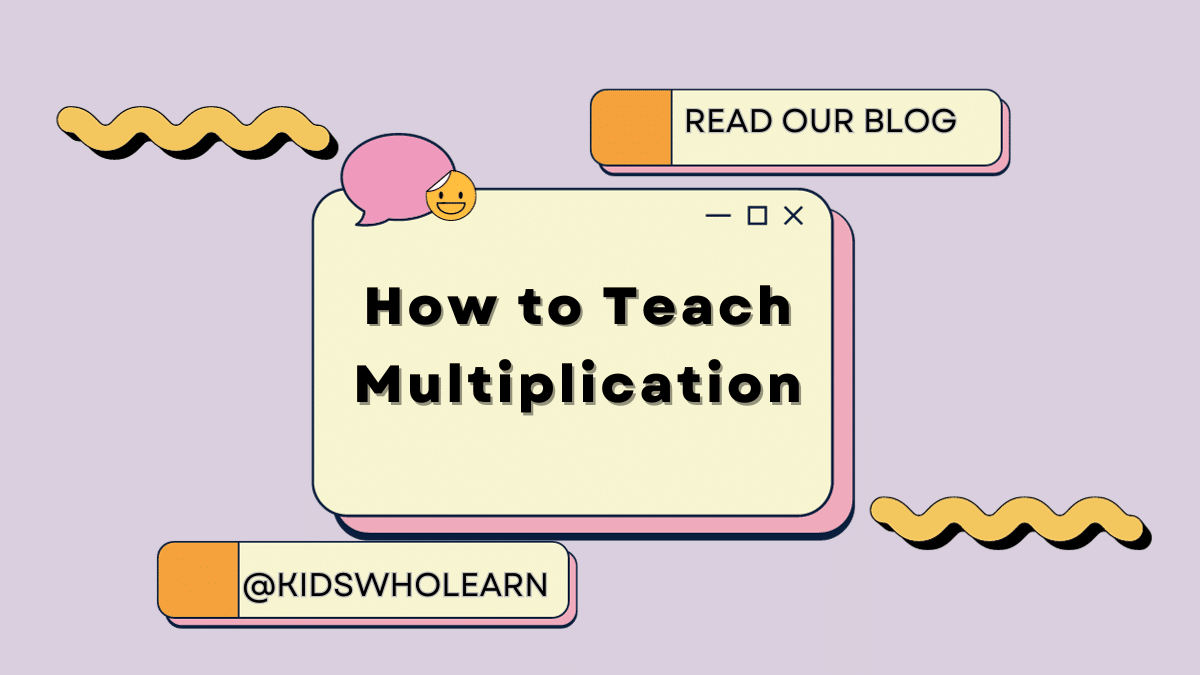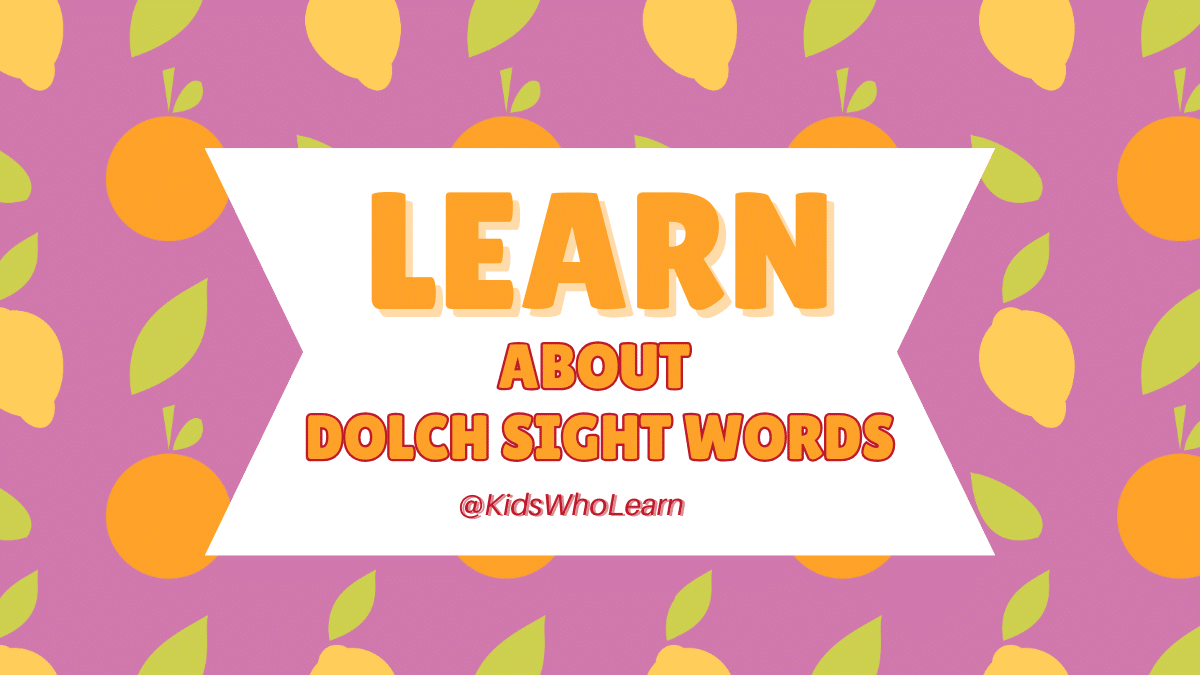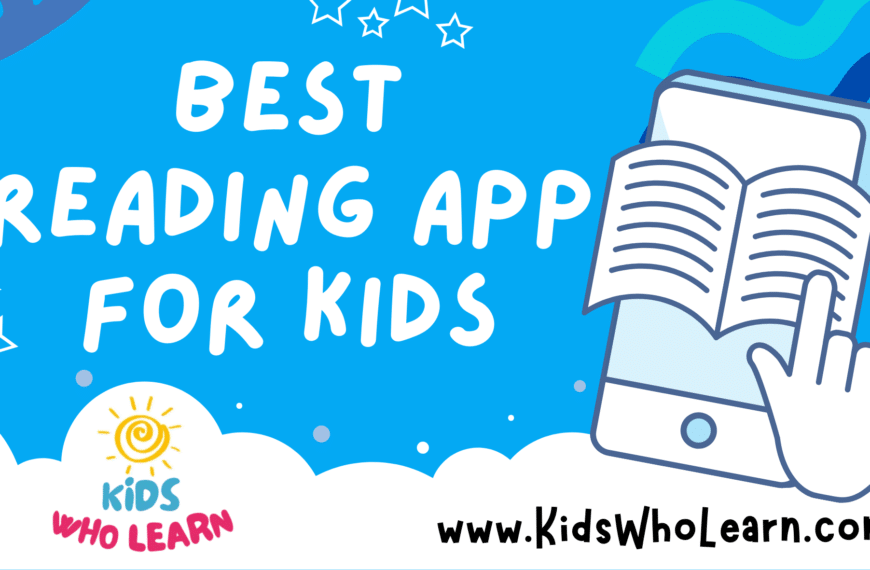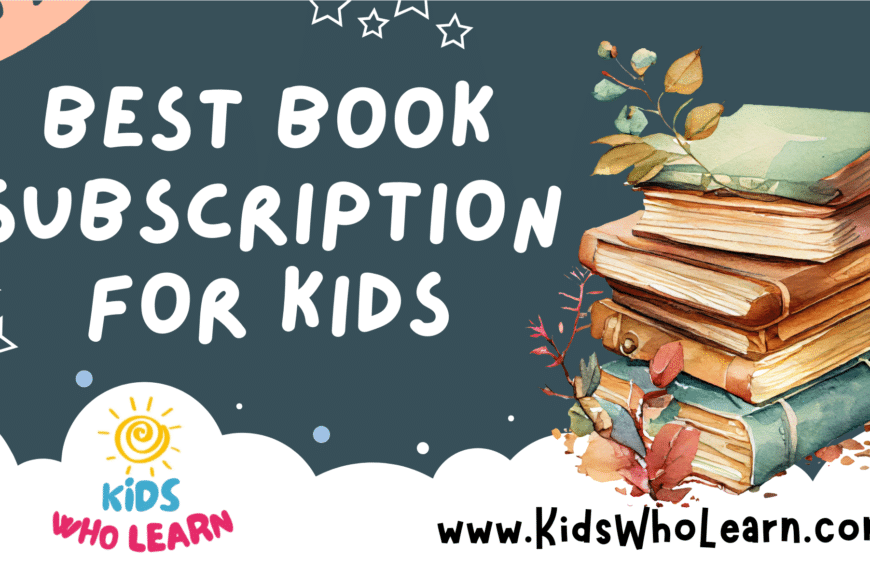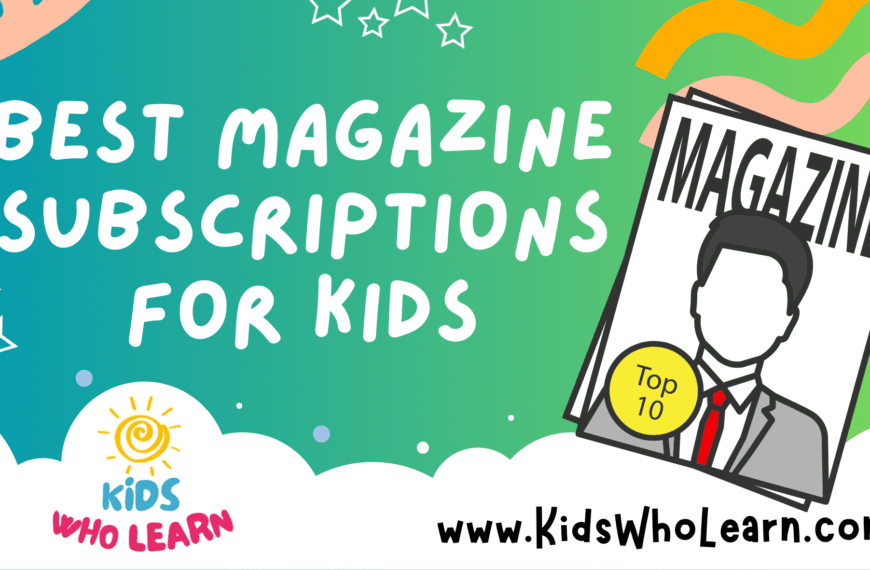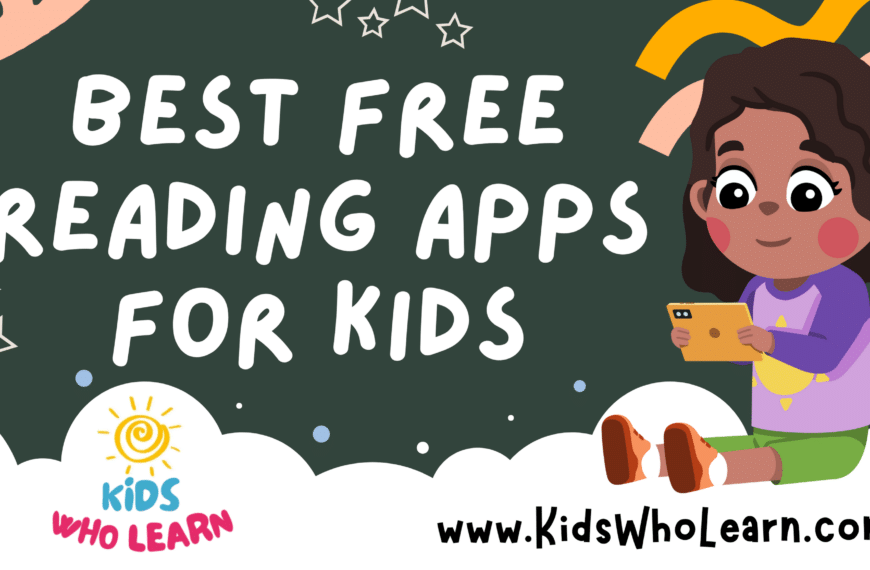
Reading is an essential skill that lays the foundation for academic success and lifelong learning. One of the critical components of early literacy development is the mastery of high-frequency instant words, also known as sight words. Here we will specifically discuss Fry Sight Words.
Among the most widely used word lists of sight words is the Fry Sight Words list, compiled by Dr. Edward Fry. This word list consists of 1,000 frequently occurring words, ordered by their frequency of use and divided into ten difficulty levels. As discussed below, teachers and parents can use Fry Sight Words as vocabulary words, spelling words, or to help achieve reading fluency.
What Are High-Frequency Instant Words, or “Sight Words?”
Instant Words are a set of the most common words used in written material and are recognized immediately by sight. These words are also known as sight words or high-frequency words, and they are essential for building reading fluency and comprehension.
Instant Words are typically taught in early literacy instruction, starting in kindergarten or first grade. These words are called “instant words” because they are meant to be recognized quickly and automatically without sounding out each letter or word.
Mastery of these words helps students read more rapidly and with greater ease, supporting their overall literacy development.
The set of Instant Words can vary depending on the literacy program or curriculum being used, but they generally include words such as “the,” “and,” “a,” “to,” “is,” “in,” “it,” “that,” “of,” and “you.” These words are frequently used in written and spoken language and are essential for reading fluency and comprehension.
What Is the Importance of Sight Words?
Sight words, also known as high-frequency instant words, are an essential component of early literacy development. Here are some reasons why sight words are important:
Achieving Reading Fluency
Sight words are words that are recognized immediately by sight without needing to be sounded out or decoded. By learning and mastering sight words, young readers can improve their reading speed and fluency.
Comprehension
Because sight words are so commonly used in written and spoken language, knowing them helps readers understand and comprehend what they are reading more easily. When students can quickly and accurately recognize sight words, they can focus their cognitive resources on understanding the meaning of the text.
Confidence
When students can recognize and read sight words quickly and easily, it helps to build their confidence as readers. This confidence can encourage them to read more frequently and explore more complex texts.
Vocabulary Development
Sight words are the most common words in written material and spoken language, so mastering these words can help students develop a more extensive vocabulary and improve their overall language skills.
Academic Success
Reading is a fundamental skill necessary for academic success in all subject areas. Students are better equipped to succeed in school and beyond by mastering sight words and developing strong reading skills.
Can High Frequency Words Be Used As Spelling Words?
High frequency words (HWF) are primarily focused on reading rather than spelling. However, learning to read and spell often goes hand in hand, and there is some overlap between HFW and commonly misspelled words.
Many HFW words are also frequently misspelled by young readers and writers, so parents and teachers may also choose to incorporate these words into spelling lessons. By recognizing and spelling these common words, students can improve their overall literacy skills and build a stronger foundation for future learning.
Additionally, some educators may use HFW words as a guide for selecting spelling words. For example, they may choose spelling words similar to or related to the HFW words taught in a particular week or unit. This approach can help students make connections between spelling and reading and reinforce their mastery of HFW words.
While HFW words primarily focus on reading, they can also be used for spelling instruction and reinforcement. Educators can help students build a strong foundation for literacy development by incorporating these words into spelling lessons.
What Are Fry Sight Words?
Fry Sight Words are one of many word lists used to teach students instant words. The Fry Sight Word List refers to a list of frequently used words in the English language that Dr. Edward Fry, a renowned educational expert, compiled. These words are also known as instant words, high-frequency words, or sight words because they are commonly used in written and spoken language and are therefore considered essential for achieving reading fluency.
The Fry Words list consists of 1,000 words, divided into ten levels based on their frequency in the English language.
The first hundred words are typically introduced in kindergarten, and the remaining words are presented in subsequent grades. The words are ordered in terms of frequency of use, with the most commonly used words appearing at the beginning of the list.
Some examples of Fry Words include “the,” “of,” “and,” “to,” “in,” “that,” “is,” “it,” “was,” and “for.” Mastery of these words is an essential milestone in early literacy development, as it allows children to read with greater ease and fluency.
What Are the Ten Levels of Fry Words?
The Fry Words list is divided into ten levels based on their difficulty and frequency in the English language. Each level includes a set of 100 high-frequency words, with the most frequently used words appearing in the earlier levels. For example, the first 100 sight words make up approximately 50% of all terms in written English material, and the first 300 words make up about 65% of all words in written English material.
Does Each Fry-Words Level Correspond to a Certain Grade?
While the Fry Words list is often used as a guide for early literacy instruction, the levels are not necessarily tied to specific grade levels.
The words in each level are ordered by their frequency of use, with the most commonly used words appearing in the earlier levels. However, the pace at which students learn and master these words can vary widely, and some students may progress through the levels more quickly or slowly than others.
That being said, the first hundred words in the Fry Words list are typically introduced in kindergarten or first grade, and the remaining words are taught in subsequent grades.
For example, Fry words 101-200 are usually taught in 2nd grade, Fry words 201-300 are taught in 3rd grade, and the remaining Fry Words (301-1000) are generally mastered in 4th and 5th grade. However, some schools and educators may introduce the words at different points in the curriculum, depending on the needs and abilities of their students.
Ultimately, the goal of teaching Fry Words is to help students develop the reading fluency and comprehension skills necessary for success in school and beyond.
What Are the First Hundred Fry Words in Level 1 of the Fry Words List (#001-100)?
The first hundred words in Level 1 of the Fry Sight Word List are:
a, about, all, am, an, and, are, as, at, be, been, but, by, called, can, come, could, day, did, do, down, each, find, first, for, from, get, go, had, has, have, he, her, him, his, how, I, if, in, into, is, it, its, like, long, look, made, make, many, may, more, my, no, not, now, number, of, on, one, or, other, out, part, people, said, see, she, so, some, than, that, the, their, them, then, there, these, they, this, time, to, two, up, use, was, water, way, we, were, what, when, which, who, will, with, words, would, write, you, your
Note that these words are considered the most accessible and frequently used in English and are often used as a starting point for early literacy instruction.
What are the 100 Fry Words in Level 2 of the Fry Words List (#101-200)?
The Fry Words in Level 2 of the Fry Sight Sight Word List are:
after, again, air, also, America, animal, another, answer, any, around, ask, away, back, because, before, big, boy, came, change, different, does, end, even, follow, form, found, give, good, great, hand, help, here, home, house, just, kind, know, land, large, learn, letter, line, little, live, man, me, means, men, most, mother, move, much, must, name, need, new, off, old, only, our, over, page, picture, place, play, point, put, read, right, same, say, sentence, set, should, show, small, sound, spell, still, study, such, take, tell, things, think, three, through, too, try, turn, us, very, want, well, went, where, why, work, world, years
Note that these words are considered slightly more complex than the first hundred words in Level 1, and they are often introduced to early readers once they have mastered the Level 1 words.
What are the 100 Fry Words in Level 3 of the Fry Words List (#201-300)?
The Fry Words in Level 3 of the Fry Sight Sight Word List are:
above, add, almost, along, always, began, begin, being, below, between, book, both, car, carry, children, city, close, country, cut, don’t, earth, eat, enough, every, example, eyes, face, family, far, father, feet, few, food, four, girl, got, group, grow, hard, head, hear, high, idea, important, Indian, it’s, keep, last, late, leave, left, let, life, light, list, might, mile, miss, mountains, near, never, next, night, often, once, open, own, paper, plant, real, river, run, saw, school, sea, second, seem, side, something, sometimes, song, soon, start, state, stop, story, talk, those, thought, together, took, tree, under, until, walk, watch, while, white, without, young
Note that these words are considered more challenging than the words in Levels 1 and 2, and they are typically introduced to students who have already developed basic reading skills.
What are the Fry Words in Level 4 of the Fry Sight Word List (#301-400)?
The Fry Words in Level 4 of the Fry Sight Sight Word List are:
across, against, area, become, best, better, birds, black, body, certain, cold, color, complete, covered, cried, didn’t, dog, door, draw, during, early, easy, ever, fall, farm, fast, field, figure, fire, fish, five, friends, ground, happened, heard, himself, hold, horse, hours, however, hundred, I’ll, king, knew, listen, low, map, mark, measure, money, morning, music, north, notice, numeral, order, passed, pattern, piece, plan, problem, products, pulled, questions, reached, red, remember, rock, room, seen, several, ship, short, since, sing, slowly, south, space, stand, step, sun, sure, table, today, told, top, toward, town, travel, true, unit, upon, usually, voice, vowel, war, waves, whole, wind, wood
Note that these words are considered more advanced than those in Levels 1-3, and they are typically introduced to students who have already mastered the previous levels of Fry words.
What are the Fry Words in Level 5 of the Fry Sight Word List (#401-500)?
The Fry Words in Level 5 of the Fry Sight Sight Word List are:
able, ago, among, ball, base, became, behind, boat, box, bread, bring, brought, building, built, cannot, carefully, check, circle, class, clear, common, contain, correct, course, dark, decided, deep, done, dry, English, equation, explain, fact, feel, filled, finally, fine, fly, force, front, full, game, gave, government, green, half, heat, heavy, hot, inches, include, inside, island, known, language, less, machine, material, minutes, note, nothing, noun, object, ocean, oh, pair, person, plane, power, produce, quickly, ran, rest, road, round, rule, scientists, shape, shown, six, size, special, stars, stay, stood, street, strong, surface, system, ten, though, thousands, understand, verb, wait, warm, week, wheels, yes, yet
What are the Fry Words in Level 6 of the Fry Words List (#501-600)?
The Fry Words in Level 6 of the Fry Sight Sight Word List are:
anything, arms, beautiful, believe, beside, bill, blue, brother, can’t, cause, cells, center, clothes, dance, describe, developed, difference, direction, discovered, distance, divided, drive, drop, edge, eggs, energy, Europe, exercise, farmers, felt, finished, flowers, forest, general, gone, grass, happy, heart, held, instruments, interest, job, kept, lay, legs, length, love, main, matter, meet, members, million, mind, months, moon, paint, paragraph, past, perhaps, picked, present, probably, race, rain, raised, ready, reason, record, region, represent, return, root, sat, shall, sign, simple, site, sky, soft, square, store, subject, suddenly, sum, summer, syllables, teacher, test, third, train, wall, weather, west, whether, wide, wild, window, winter, wish, written
What are the Fry Words in Level 7 of the Fry Words List (#601-700)?
The Fry Words in Level 7 of the Fry Sight Sight Word List are:
alone, art, bad, bank, bit, break, brown, burning, business, captain, catch, caught, cents, child, choose, clean, climbed, cloud, coast, continued, control, cool, cost, decimal, desert, design, direct, drawing, ears, east, else, engine, England, equal, experiment, express, feeling, fell, flow, foot, garden, gas, glass, God, grew, history, human, hunting, increase, information, itself, joined, key, lady, law, least, lost, maybe, mouth, party, pay, period, plains, please, practice, president, received, report, ring, rise, row, save, seeds, sent, separate, serve, shouted, single, skin, statement, stick, straight, strange, students, suppose, symbols, team, touch, trouble, uncle, valley, visit, wear, whose, wire, woman, wrote, yard, you’re, yourself
What are the Fry Words in Level 8 of the Fry Words List (#701-800)?
The Fry Words in Level 8 of the Fry Sight Sight Word List are:
alone, art, bad, bank, bit, break, brown, burning, business, captain, catch, caught, cents, child, choose, clean, climbed, cloud, coast, continued, control, cool, cost, decimal, desert, design, direct, drawing, ears, east, else, engine, England, equal, experiment, express, feeling, fell, flow, foot, garden, gas, glass, God, grew, history, human, hunting, increase, information, itself, joined, key, lady, law, least, lost, maybe, mouth, party, pay, period, plains, please, practice, president, received, report, ring, rise, row, save, seeds, sent, separate, serve, shouted, single, skin, statement, stick, straight, strange, students, suppose, symbols, team, touch, trouble, uncle, valley, visit, wear, whose, wire, woman, wrote, yard, you’re, yourself
What are the Fry Words in Level 9 of the Fry Words List (#801-900)?
The Fry Words in Level 9 of the Fry Sight Sight Word List are:
addition, army, bell, belong, block, blood, blow, board, bones, branches, cattle, chief, compare, compound, consider, cook, corner, crops, crowd, current, doctor, dollars, eight, electric, elements, enjoy, entered, except, exciting, expect, famous, fit, flat, fruit, fun, guess, hat, hit, indicate, industry, insects, interesting, Japanese, lie, lifted, loud, major, mall, meat, mine, modern, movement, necessary, observe, park, particular, planets, poem, pole, position, process, property, provide, rather, rhythm, rich, safe, sand, science, sell, send, sense, seven, sharp, shoulder, sight, silent, soldiers, spot, spread, stream, string, suggested, supply, swim, terms, thick, thin, thus, tied, tone, trade, tube, value, wash, wasn’t, weight, wife, wings, won’t
What are the Fry Words in Level 10 of the Fry Words List (#901-1000)?
What are the Fry Words in Level 10 of the Fry Words List (#901-1000)?
The Fry Words in Level 10 of the Fry Sight Sight Word List are:
action, actually, adjective, afraid, agreed, ahead, allow, apple, arrived, born, bought, British, capital, chance, chart, church, column, company, conditions, corn, cotton, cows, create, dead, deal, death, details, determine, difficult, division, doesn’t, effect, entire, especially, evening, experience, factories, fair, fear, fig, forward, France, fresh, Greek, gun, hoe, huge, isn’t, led, level, located, march, match, molecules, northern, nose, office, opposite, oxygen, plural, prepared, pretty, printed, radio, repeated, rope, rose, score, seat, settled, shoes, shop, similar, sir, sister, smell, solution, southern, steel, stretched, substances, suffix, sugar, tools, total, track, triangle, truck, underline, various, view, Washington, we’ll, western, win, women, workers, wouldn’t, wrong, yellow
How Do You Use a Fry Word List?
The Fry word list is a valuable resource for teaching basic sight vocabulary to young readers. Here are some ways to use the Fry word list to support reading instruction:
- Start with the first 100 words:
Begin with the first 100 words on the Fry list, which are the most frequently used words in the English language. These words make up about 50% of all written material. Use flashcards or other visual aids to help students learn to recognize and read each word.
- Move on to the second 100 words:
Once students have mastered the first 100 words, move on to the second 100 words on the Fry list. These words make up about 25% of all written material.
- Use the remaining words on the list:
After students have mastered the first 200 words, continue to work through the remaining words on the Fry list. These words are less frequent but still important for students to know in order to become proficient readers.
- Integrate sight words into reading instruction:
As students learn new sight words, integrate them into reading instruction by having students read short sentences that include the new words.
- Practice, practice, practice:
Regular practice is key to helping students learn and retain sight words. Encourage students to practice reading sight words regularly, using flashcards, games, or other interactive activities.
- Monitor progress:
Keep track of students’ progress and provide extra support and practice for students who are struggling to learn and recognize sight words.
By using the Fry word list as a guide, teachers and parents can help young readers develop the basic sight vocabulary they need to become proficient readers.

